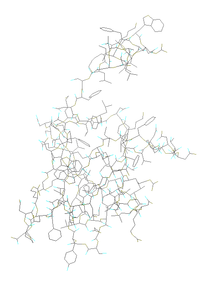Medicinal uses of fungi
Medicinal fungi are
History
Although fungi products have long been used in traditional medicine, the ability to identify beneficial properties and then extract the active ingredient started with the discovery of penicillin by Alexander Fleming in 1928.[1] Since that time, many potential antibiotics were discovered and the potential for various fungi to synthesize biologically active molecules useful in various clinical therapies has been under research. Pharmacological research identified antifungal, antiviral, and antiprotozoan compounds from fungi.[2]
Research and drug development
Cancer
There is no good evidence that any type of mushroom or mushroom extract can prevent or cure cancer.
11,11'-
Penicillium is a potential source of the leukemia medicine asparaginase.[7]
Some countries have approved beta-glucan fungal extracts lentinan, polysaccharide-K, and polysaccharide peptide as immunologic adjuvants.[8]
Antibacterial agents (antibiotics)
Alexander Fleming led the way to the beta-lactam antibiotics with the Penicillium mold and penicillin. Subsequent discoveries included alamethicin, aphidicolin, brefeldin A, cephalosporin,[9] cerulenin, citromycin, eupenifeldin, fumagillin,[9] fusafungine, fusidic acid,[9] helvolic acid,[9] itaconic acid, MT81, nigrosporin B, usnic acid, verrucarin A, vermiculine and many others.

Antibiotics retapamulin, tiamulin, and valnemulin are derivatives of the fungal metabolite pleuromutilin. Plectasin, austrocortilutein, austrocortirubin, coprinol, oudemansin A, strobilurin, illudin, pterulone, and sparassol are under research for their potential antibiotic activity.[citation needed]
Cholesterol biosynthesis inhibitors
Antifungals
Some antifungals are derived or extracted from other fungal species.
Antivirals
Many mushrooms contain potential antiviral compounds remaining under preliminary research, such as: Lentinus edodes, Ganoderma lucidum, Ganoderma colossus, Hypsizygus marmoreus, Cordyceps militaris, Grifola frondosa, Scleroderma citrinum, Flammulina velutipes, and Trametes versicolor, Fomitopsis officinalis.[14][15][16][17]
Immunosuppressants
Malaria
Codinaeopsin, efrapeptins, zervamicins, and antiamoebin are made by fungi, and remain under basic research.[19]
Diabetes
Many fungal isolates act as
Psychotropic effects
Numerous fungi have well-documented psychotropic effects, some of them severe and associated with acute and life-threatening side-effects.
The history of bread-making records deadly ergotism caused by
Vitamin D2

Fungi are a source of
Yeasts
The yeast
References
- ^ "Discovery and Development of Penicillin". American Chemical Society, International Historic Chemical Landmarks. 2020. Retrieved 11 March 2020.
- S2CID 7189999.
- S2CID 22145043.
- ^ "Medicinal mushrooms in cancer treatment". Cancer Research UK. Retrieved 4 November 2022.
- ^ Trafton, Anne (27 February 2013). "Research update: Chemists find help from nature in fighting cancer". MIT News.
- PMID 16279417.
- S2CID 30396788.
- PMID 23092289.
- ^ S2CID 23442996.
- ^ S2CID 3344720.
- PMID 23118499.
- ISBN 978-0-683-30740-5.
- ISBN 978-1-4051-1578-0.
- S2CID 181538245.
- PMID 28231175.
- S2CID 51629395.
- PMID 30834150.
- PMID 20564278.
- PMID 11120957.
- PMID 22324407.
- ^ a b "Hallucinogenic mushrooms drug profile". The European Monitoring Centre for Drugs and Drug Addiction.
- ^ PMID 17149427.
- ^ Shiel, William C. "Medical Definition of Ergotism". MedicineNet. Retrieved 18 October 2020.
- PMID 17202453.
- PMID 24494050.
- PMID 27481154.
- PMID 30322118.
- ^ Peplow, Mark (16 April 2013). "Sanofi launches malaria drug production". Chemistry World.
External links
- Memorial Sloan-Kettering Agaricus subrufescens, Phellinus linteus, Ganoderma lucidum, Trametes versicolor and PSK, Grifola frondosa, Inonotus obliquus, Pleurotus ostreatus, Cordyceps, Shiitake, Lentinan, AHCC.
- American Cancer Society Trametes versicolor and PSK, Grifola frondosa Archived 2010-03-31 at the Wayback Machine, Shiitake Archived 2009-06-14 at the Wayback Machine.
- National Cancer Institute Shiitake, Lentinan, Cordycepin
